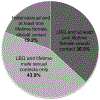Differences by sexual minority status in relationship abuse and sexual and reproductive health among adolescent females
- PMID: 24962502
- PMCID: PMC6707724
- DOI: 10.1016/j.jadohealth.2014.04.020
Differences by sexual minority status in relationship abuse and sexual and reproductive health among adolescent females
Abstract
Purpose: Little is known about adolescent relationship abuse (ARA) and related sexual and reproductive health among females who either identify as lesbian or bisexual or engage in sexual behavior with female partners (i.e., sexual minority girls [SMGs]).
Methods: Baseline data were collected from 564 sexually active girls ages 14-19 years seeking care at eight California school-based health centers participating in a randomized controlled trial. Associations between ARA, sexual minority status and study outcomes (vaginal, oral, and anal sex, number and age of sex partners, contraceptive nonuse, reproductive coercion, sexually transmitted infection [STI] and pregnancy testing) were assessed via logistic regression models for clustered survey data.
Results: SMGs comprised 23% (n = 130) of the sample. Controlling for exposure to ARA, SMGs were less likely to report recent vaginal sex (adjusted odds ratio [AOR], .51; 95% confidence interval [CI], .35-.75) and more likely to report recent oral sex (AOR, 2.01; 95% CI, 1.38-2.92) and anal sex (AOR, 1.76; 95% CI, 1.26-2.46) compared with heterosexual girls. Heterosexual girls with ARA exposure (AOR, 2.85; 95% CI, 1.07-7.59) and SMGs without ARA exposure (AOR, 3.01; 95% CI, 2.01-4.50) were more likely than nonabused heterosexual girls be seeking care for STI testing or treatment than heterosexual girls without recent victimization.
Conclusions: Findings suggest the need for attention to STI risk among all girls, but SMGs in particular. Clinicians should be trained to assess youth for sexual contacts and sexual identity and counsel all youth on healthy relationships, consensual sex, and safer sex practices relevant to their sexual experiences.
Keywords: Adolescent relationship abuse; Sexual minority youth; Sexually transmitted infections.
Copyright © 2014 Society for Adolescent Health and Medicine. Published by Elsevier Inc. All rights reserved.
Conflict of interest statement
Figures
Similar articles
-
Sexual and Reproductive Health Indicators and Intimate Partner Violence Victimization Among Female Family Planning Clinic Patients Who Have Sex with Women and Men.J Womens Health (Larchmt). 2015 Aug;24(8):621-8. doi: 10.1089/jwh.2014.5032. Epub 2015 May 11. J Womens Health (Larchmt). 2015. PMID: 25961855 Free PMC article.
-
Cyber dating abuse among teens using school-based health centers.Pediatrics. 2014 Dec;134(6):e1560-7. doi: 10.1542/peds.2014-0537. Epub 2014 Nov 17. Pediatrics. 2014. PMID: 25404724
-
Sexual Behaviors and Partner Characteristics by Sexual Identity Among Adolescent Girls.J Adolesc Health. 2016 Mar;58(3):310-6. doi: 10.1016/j.jadohealth.2015.11.001. J Adolesc Health. 2016. PMID: 26903429 Free PMC article.
-
Adolescent relationship abuse and reproductive and sexual coercion among teens.Curr Opin Obstet Gynecol. 2013 Oct;25(5):364-9. doi: 10.1097/GCO.0b013e328364ecab. Curr Opin Obstet Gynecol. 2013. PMID: 24018873 Review.
-
Society for Adolescent Medicine Position Paper on Reproductive Health Care for Adolescents.J Adolesc Health. 1991 Dec;12(8):649-61. doi: 10.1016/1054-139x(91)90014-o. J Adolesc Health. 1991. PMID: 1839215 Review.
Cited by
-
Reproductive coercion, intimate partner violence, and pregnancy risk among adolescent women with a history of foster care involvement.Child Youth Serv Rev. 2021 Jan;120:105731. doi: 10.1016/j.childyouth.2020.105731. Epub 2020 Nov 19. Child Youth Serv Rev. 2021. PMID: 33716368 Free PMC article.
-
Teen Pregnancy Among Sexual Minority Women: Results From the National Longitudinal Study of Adolescent to Adult Health.J Adolesc Health. 2016 Oct;59(4):429-37. doi: 10.1016/j.jadohealth.2016.05.009. Epub 2016 Jul 18. J Adolesc Health. 2016. PMID: 27444867 Free PMC article.
-
Sexual Initiation Patterns of U.S. Sexual Minority Youth: A Latent Class Analysis.Perspect Sex Reprod Health. 2017 Mar;49(1):55-67. doi: 10.1363/psrh.12020. Epub 2017 Mar 2. Perspect Sex Reprod Health. 2017. PMID: 28253427 Free PMC article.
-
A Systematic Review of Reproductive Coercion in International Settings.World Med Health Policy. 2016 Dec;8(4):382-408. doi: 10.1002/wmh3.209. Epub 2016 Nov 10. World Med Health Policy. 2016. PMID: 28503353 Free PMC article.
-
Reproductive Coercion and Relationship Abuse Among Adolescents and Young Women Seeking Care at School Health Centers.Obstet Gynecol. 2019 Aug;134(2):351-359. doi: 10.1097/AOG.0000000000003374. Obstet Gynecol. 2019. PMID: 31306331 Free PMC article.
References
-
- Silverman JG, McCauley HL, Decker MR, et al. Coercive forms of sexual risk and associated violence perpetrated by male partners of female adolescents. Perspect Sex Reprod Health 2011;43:60–5. - PubMed
-
- Silverman JG, Raj A, Mucci LA, et al. Dating violence against adolescent girls and associated substance use, unhealthy weight control, sexual risk behavior, pregnancy, and suicidality. JAMA 2001;286:572–9. - PubMed
Publication types
MeSH terms
Grants and funding
LinkOut - more resources
Full Text Sources
Other Literature Sources
Medical


